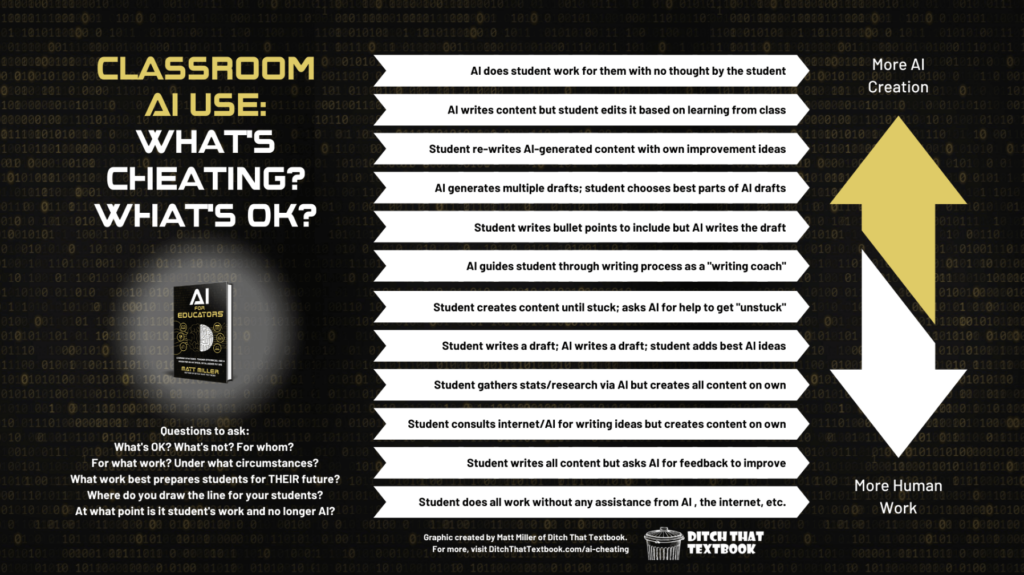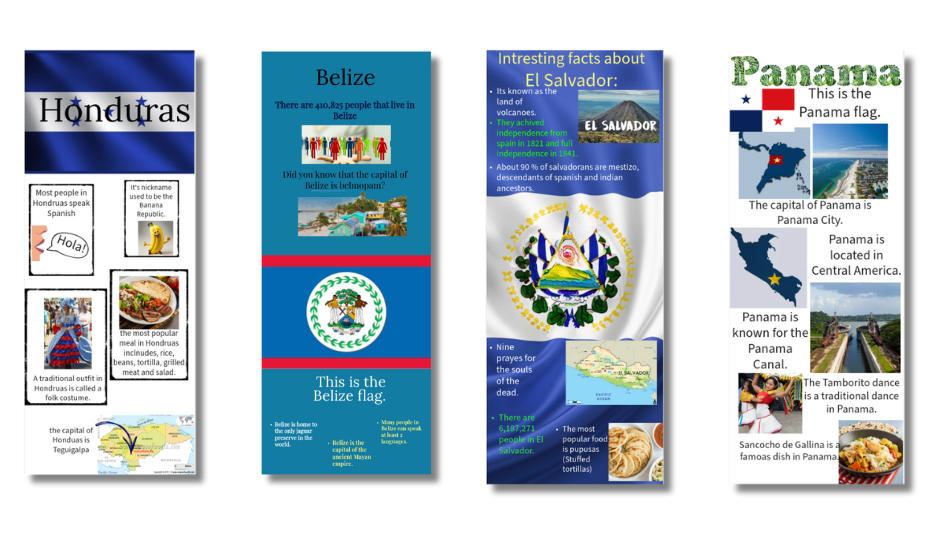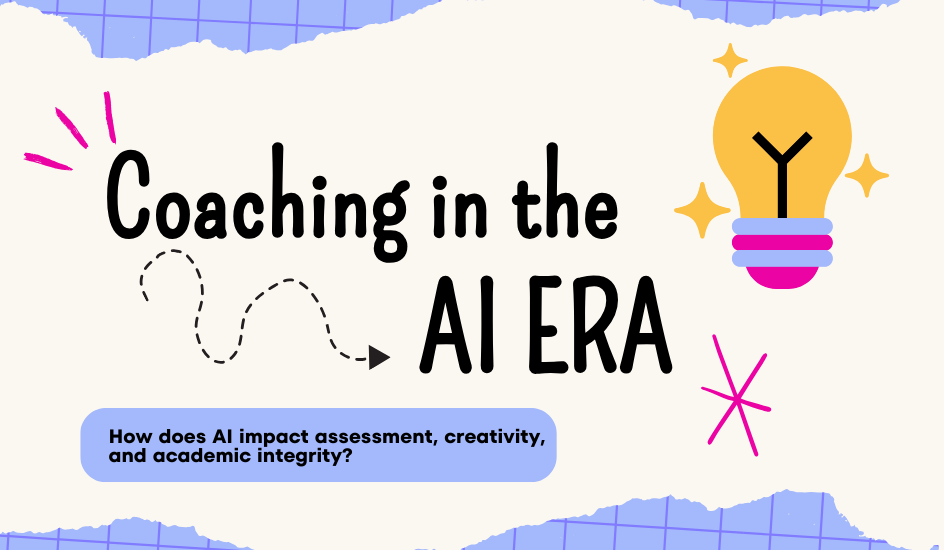I started teaching with blackboards and overhead projectors. Reflecting on my first classroom teacher experience, those marker-stained hands and forever dusty erasers are truly a core memory for me. I wrote my first technology grant for a projector a few years later. It was innovative. It was exciting. It was loud. And I’m sure it was more expensive than they are now, but I was stoked! I couldn’t sleep because I was thrilled to enhance my students’ learning through something considered to be high-tech. Technology has that spark. It can completely transform a classroom’s experience of content and learning. Walk through the vendor hall at a major conference (like TCEA’s Convention & Exposition) and experience it firsthand. The latest “spark” in technology to completely light up education? AI.
Three Trending Topics About AI in Education
AI is making educators completely rethink lesson plans, classwork, homework, and assessments. I’ve been lucky enough to present about AI to hundreds of educators. The most common comments and questions I hear surrounding AI in education can be wrapped up in these three topics:
- Cheating
- Assessment
- Creativity
As coaches, how can we tackle these topics with our coaching? First, by becoming learners ourselves.
Learning About AI as a Coach
When news of ChatGPT hit the scene last winter, I started digging into the topic. I read articles, followed the conversations on Twitter, and attended one of the first AI sessions with Matt Miller and Holly Clark at TCEA’s Convention & Exposition. The best way to learn is to do. So, I created my own OpenAI account, and off I went. Then, I co-wrote a course for the Microsoft Learn platform called “Empowering Educators to Explore the Potential of AI.” Through this process, I was able to really deeply understand what AI is and, more importantly, what it is not. As a technology integration specialist, I found that it was part of my job to learn as much as I could about this topic so I could better equip teachers and administrators as we embarked on this unprecedented journey together.
AI and Cheating
Back in the winter of 2022, I started to broach the topic of AI during my monthly check-ins with administrators. This eventually led to my counterparts across the district and me to lead sessions with staff to ensure we were all on the same page regarding what AI is, what it is not, and how we would define “cheating.” I demonstrated the continuum of “cheating,” with AI that Matt Miller showcased at TCEA in February 2023. Staff really resonated with this graphic, and many of them turned around and shared it with their own students to spark conversation.

As a technology team, we collaborated with academic services to create a universal approach to AI as a district. We wanted to deliver a unified message that we as a staff in Zionsville Community Schools were preparing our students for their tomorrow. We’re not going back to paper and pencil. We’re not blocking AI. We’re adding our voice to the algorithm as it continues to learn. And, most importantly, we’re creating an equitable experience for our learners by teaching them how to learn with AI in school.
AI and Assessment
So now that the genie was out of the bottle, and there was no going back, how do teachers accurately assess students? It seemed like one more thing to worry about and something new added to teachers’ plates, again! This was where I leaned into a philosophy that really started to put my teachers at ease.
This isn’t anything we haven’t been preparing for already.
Our teachers had already seen the SAMR model and worked with the (DOK) Depths of Knowledge. If we’re truly leaning into those deeper levels of the SAMR model, students will be redefining their learning by creating podcasts instead of hacking out that informative writing essay. AI can’t create that podcast for them. If we approach our assessments with the idea that students are hitting level four of the DOK, our learners would be better thinkers. For instance, instead of having students write a summary of a book they read, why not have them analyze a character from the book they read while recording a video in Flip based on the text and conversations in the class? AI can’t create that video for them.
Teachers and I have been leaning into the question: “Is this assessment enhanced with or replaced by AI?” Recently, I was working with a group of 4th grade teachers on their upcoming book reports. They were trying to jazz these up to make them more engaging. Jennifer Lawrence teaches at Eagle Elementary. She is always excited to try anything new in technology! We began to explore this thought: “Now that we know AI can create book reports for students, let’s look at the standards and think about what students can create for this assessment instead.” This conversation resulted in 4th grade students creating their own infographics using Adobe Express!

We even discussed how AI could help ease the burden of this project for the teacher. For example, using tools like MagicSchool.ai to create standards-aligned rubrics can be a huge time-saver. Additionally, the students learned how to use the Adobe Express text-to-image AI tool to enhance their project. The standards for informative writing were still being assessed, yet the assessment was enhanced with the use of AI not replaced by it.
AI and Creativity
I was able to attend Adobe’s Creative Educator event with an amazing cohort of creative educators this past summer in New York City. Scott Belsky, executive VP of Design for Adobe, shared some ideas with us as a group. He spoke about how productivity used to be the marker of a good solid employee. Now, with AI, that is going to level the playing field. So how do we stand out in the workforce? We leverage our creativity. The human brain can create and innovate. Now that it doesn’t have to be bogged down by mundane tasks, what does it have time to do? What do our teachers now have time to do if their tasks are being automated, lesson plans are being created, and data is being analyzed faster than ever before? What’s next?
As I ended this winter break nearly 15 years after that first transformative technology in my classroom, I can’t help but get excited about what is still to come. Technology is always ever-evolving, and so are we as educators. We’re always learning and always ready for that next big spark.
Don’t miss Stevie Frank at TCEA 2024! She’ll be presenting four sessions at this year’s convention:
- Pass the Mic: Student-Driven Podcasts
- Peary Engaging: Transforming Formative Assessment with Pear Deck
- Classy Doodles: OneNote and Sketchnoting Magic
- Microsoft Onenote: Your Digital Trapper Keeper
For 44 years, TCEA’s Convention & Exposition has been a place where thousands of educators gather to learn, grow, and explore. You don’t want to miss it!


2 comments
Very good article. I had the blackboard and handwriting and typing class. I am glad my children are grown as the technology is a big learning curve for parents working fulltime, taking the children to sports or family activities or maybe going to school themselves. The cost of technology was prohibitive when raising our children but the demand was kept at school and not brought home. As exciting as all this creativity of technology is – please keep in mind that some children need more time to adapt to these skills when it is not in the home.
Karen, thanks for engaging in this article! I couldn’t agree more when it comes to equity and ensuring that ALL students have equal access to evolving technology.